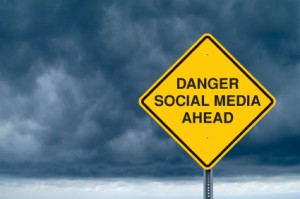Social Media for Business Leaders
 As a marketing guy, I understand (sort of) the marketing aspects of social media. If you can start a conversation — and keep it interesting — you can engage your market in ways that are impossible with “interruption marketing”. You can exchange ideas, gather suggestions, support charities, and engage in positive social activities. Along the way, you can mention your products. You offer something of interest (or utility) and the products tag along for the ride.
As a marketing guy, I understand (sort of) the marketing aspects of social media. If you can start a conversation — and keep it interesting — you can engage your market in ways that are impossible with “interruption marketing”. You can exchange ideas, gather suggestions, support charities, and engage in positive social activities. Along the way, you can mention your products. You offer something of interest (or utility) and the products tag along for the ride.
But social media is not just about marketing. Executives should be able to use social media to enhance both internal and external communication. Yet, I haven’t found many examples in the literature. Fortunately, McKinsey just published an interesting case study based on GE’s experience. The authors, who are GE leaders themselves, point out that GE is not a “digital native” and its experiences may, therefore, be relevant to a wide range of organizations. They then outline six social media skills that all leaders need to learn. The first three are personal; the last three are strategic or organizational.
Producer — creating compelling content. Digital video tools are now widely available and easy to use. Even busy senior executives can weave them into their communications. As compared to traditional top-down communications, the emphasis shifts from high production quality to authenticity. The goal is to invite participation and collaboration. Speaking plainly and telling stories in an authentic voice invites participation much better than a highly produced video.
Distributor — leveraging dissemination dynamics. Instead of sending a message and expecting it be consumed, you now send a message and expect it to be mashed up. A successful social message will be picked up by people at all levels of the organization, commented on, “recontextualized”, and forwarded along. You want this to happen which means giving up a significant amount of control — not always an easy concept for executives. You also want to build up a followership within the organization long before you need it.
Recipient — managing communication overflow. We’re already drowning in information. Why take on social media? Because it’s more credible than top-down media. By learning to use filters effectively, you can also use social media to manage the flow of information to and from your desk. You should practice when and how to respond to postings and tweets. You don’t need to respond frequently but you do need to respond thoughtfully.
Advisor and orchestrator — driving strategic social media utilization. Fundamentally, executives need to promote the use of social media and guide it to maturity. Your company may be enthusiastic but inexperienced. Or you may have leaders who wish to avoid it altogether. A good leader can harness the enthusiasm of “digital natives” and even use them as “reverse mentors” to build capabilities within the organization.
Architect — creating an enabling organizational infrastructure. On the one hand, you want to encourage collaboration and free exchange. On the other hand, you need some rules. It helps if you have well-established values of integrity, collaboration, and transparency. If your company hasn’t established these values, it’s time to get started. Social media will arise in your organization whether you’re ready or not.
Analyst — staying ahead of the curve. As your organization masters social media, something new will emerge. Perhaps, it’s the Internet of Things. As I’ve noted before, this could help us reduce health care costs. It could also have huge implications for your organization — both good and bad. Better stay awake.
And what do you get if your company’s leaders master these skills? The authors say it best: “We are convinced that organizations that … master … organizational media literacy will have a brighter future. They will be more creative, innovative, and agile. They will attract and retain better talent, as well as tap deeper into the capabilities and ideas of their employees and stakeholders.”
Sunday Shorts – 7
Interesting stuff from this week and beyond.
Just what is the circular economy and are you ready for it? Reverse logistics anyone?
We’ve talked about design thinking versus systems thinking. What about manufacturing thinking? Can good design produce good manufacturing? Or is it the other way round?
Can your company overdo it on social media? There’s a good chance that you already are.
What personality type makes the best salespeople? It’s not the hard-charger. Or even the most outgoing. People with “moderate temperaments” make the most sales.
Dung beetles aren’t very smart. But they can navigate by the stars. Maybe they’re smarter than we thought.
Bleeding internally? Injecting a foam through your belly button could stop it. But you still need to go to the hospital.
Have the mid-January blues? Need a little excitement in your life? Here’s how to set your cocktails on fire.
Does your e-mail address say you’re a psychopath?
 The first thing I know about a person is often their e-mail address. From that small scrap of information, I start building an image of what the person is like. If you think first impressions are important, think about what your e-mail address says about you. Your e-mail address is often the first element of your personal brand.
The first thing I know about a person is often their e-mail address. From that small scrap of information, I start building an image of what the person is like. If you think first impressions are important, think about what your e-mail address says about you. Your e-mail address is often the first element of your personal brand.
Some people use their e-mail addresses to identify their hobbies or interests, like bookworm@xyz.com or bikerbob@wxy.com. But I’m usually more interested in the information after the @ sign. If I receive an e-mail from an @aol.com address, I think the sender is over the hill and out of date. If it comes from a cable company (e.g. @comcast.net), I think they’re not very technically astute. If they change cable companies, they’ll have to change their e-mail address as well. How boring!
I thought I might be alone in these perceptions so I was interested to learn that no less an authority than the New York Times‘ David Pogue has similar biases. In an article in yesterday’s Times, Pogue introduced Microsoft’s new e-mail service. In passing, Pogue referred back to Microsoft’s previous service, Hotmail. Pogue writes that, “Even today, a Hotmail address still says ‘unsophisticated loser’ in some circles.”
For these reasons, I was deeply disappointed when Apple tried to shift its e-mail service from @mac.com to @me.com. My e-mail address has long been a variant of myname@mac.com. Part of my personal brand is that I use a Mac. It’s OK with me if people know that. Maybe they’ll think that I “think different”. When Apple changed it to me.com, I was horrified. In my humble opinion, anyone who uses an e-mail address of myname@me.com is self-centered at best or a psychopath at worst. Even if I think “it’s all about me” (and I do sometimes), I don’t want to project it in my personal brand. Thankfully, I can still use @mac.com designation and I hope I always will.
I teach my students that they need to think about their personal brand. It’s important for getting a job or a promotion. Your brand is a combination of how you behave, how you speak, how you dress, and so on. Each of those sends clues about who you are and whether you’d be good teammate or not. When you think about your brand, begin at the beginning — your e-mail address.
